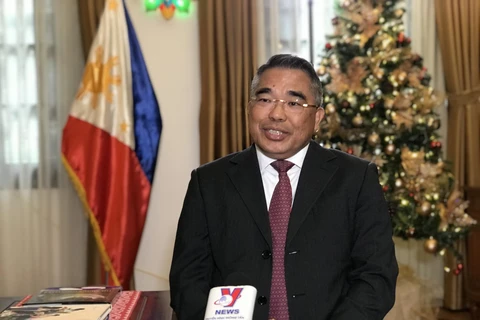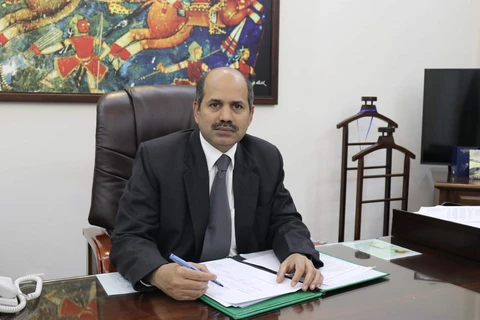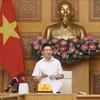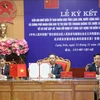Hanoi (VNS/VNA) - Although the economy was forecast to continue facing difficulties and challenges in 2023, there were silver linings to pin hope on, experts said.
According to Nguyen Duc Hien, Vice Chairman of the Party Central Committee’s Economic Commission, there were unpredictable factors that would have a significant impact on the country’s socioeconomic development.
Many international organisations forecast that global economic growth would slow down with regions and countries at risk of falling into recession, Hien said.
Some of 10 countries and territories that accounted for more than 71% of Vietnam’s export revenue, including the US, the Republic of Korea (RoK), Japan, the Netherlands, Germany, the UK and Hong Kong, were forecast to face a mild economic recession in the short term. This would affect some industries of Vietnam such as garment and textile, footwear and furniture, he said.
Among 10 countries and territories which accounted for more than 80% of Vietnam’s import revenue, Japan, the RoK, the US, Malaysia, Taiwan and Indonesia were forecast to be affected by the economic recession in 2023.
Regarding investment, among the 10 largest foreign investors in Vietnam which altogether accounted for 93% of the total FDI into the country, except for China and Thailand, the rest, including Singapore, the RoK, Japan, Taiwan, Hong Kong and the US were forecast to show signs of falling onto recession at different degrees.
The Vietnamese Government’s goals of achieving economic growth of 6.5% and inflation at 4.5% would be a challenge if the management was not flexible enough, he stressed.
It was necessary for Vietnam to develop different scenarios to raise solutions on both short and long terms to maintain macroeconomic stability and ensure major balances of the economy, he said.
Nguyen Xuan Thanh from Fullbright University Vietnam said that difficulties would remain in the second half of this year. However, there was still light at the end of the tunnel for Vietnam to change policies and solve the internal problems of the Vietnamese economy.
Looking at the monetary policies of counties around the world, Thanh said that the US Federal Reserves (Fed) might continue to raise rates. In the worst scenario, Fed could raise rates in February, March and May, and then maintain the rate at 5-5.25% to the end of 2023.
The second factor was the border reopening of China after three years of being shut to fight the COVID-19 pandemic. He said that from April or May, the reopening would give a push to domestic demand, create opportunities for Vietnam’s exports and attract Chinese tourists.
In strategic competition, Vietnam relied on public investment and domestic consumption to compensate for the decline in exports. However, in order to have a bright economic picture, it was also necessary to promote the disbursement of FDI and public investment, Thanh said, adding that the monetary policy must be flexible and interest rates must be lowered.
Can Van Luc, a member of the National Financial and Monetary Policy Advisory Council, said that public investment was increased in 2023 as an important growth driver.
Under the socio-economic recovery programme, development investment in 2023 was estimated at nearly 739 trillion VND, accounting for 35% of the total State budget expenditure and more than 38% higher than the plan in 2022.
A notable point in 2023 was that Vietnam was accelerating economic restructuring, improving institutions with a series of laws to be discussed for amendments such as the Law on Land, the Law on Housing, the Law on Real Estate Business, and the Law on Credit Institutions.
“Basically, Vietnam’s macro foundation is much stronger than before and continues to be relatively stable," Luc said.
"With experiences in fighting against the pandemic, risk management and crisis handling and medium fiscal risk, there was room for growth in 2023.”
Former Director of the General Statistic Office Nguyen Bich Lam said that developing a transparent institution would give a significant impetus to drive economic growth this year.
Standing Deputy Minister of Foreign Affairs Nguyen Minh Vu said in the context of rising global uncertainties, the Vietnamese economy with high openness was strongly affected but it also proved its adaptability and resilience.
He pointed out that there were three notable trends in the world economy. Firstly, the global economy was losing its growth momentum and facing the risk of a technical recession. The International Monetary Fund forecast that one-third of the world’s economies would be in recession in 2023 with growth drivers such as export, investment and global consumption expected to decline.
Secondly, structural transformations would continue to reshape the global economy with new principles and rules in governance such as green trade and global minimum tax. In that context, the strategic competition of major economies would intensify.
Thirdly, the Asia – Pacific region, including Southeast Asia was considered the driving force for global economic growth.
“The picture is not all grey," he said.
"There are opportunities. If we could tune into the new trends and take advantage of new growth drivers from the green economy and digital transformation, we can optimise resources to overcome challenges. It’s also time for enterprises to create breakthroughs.”/.
According to Nguyen Duc Hien, Vice Chairman of the Party Central Committee’s Economic Commission, there were unpredictable factors that would have a significant impact on the country’s socioeconomic development.
Many international organisations forecast that global economic growth would slow down with regions and countries at risk of falling into recession, Hien said.
Some of 10 countries and territories that accounted for more than 71% of Vietnam’s export revenue, including the US, the Republic of Korea (RoK), Japan, the Netherlands, Germany, the UK and Hong Kong, were forecast to face a mild economic recession in the short term. This would affect some industries of Vietnam such as garment and textile, footwear and furniture, he said.
Among 10 countries and territories which accounted for more than 80% of Vietnam’s import revenue, Japan, the RoK, the US, Malaysia, Taiwan and Indonesia were forecast to be affected by the economic recession in 2023.
Regarding investment, among the 10 largest foreign investors in Vietnam which altogether accounted for 93% of the total FDI into the country, except for China and Thailand, the rest, including Singapore, the RoK, Japan, Taiwan, Hong Kong and the US were forecast to show signs of falling onto recession at different degrees.
The Vietnamese Government’s goals of achieving economic growth of 6.5% and inflation at 4.5% would be a challenge if the management was not flexible enough, he stressed.
It was necessary for Vietnam to develop different scenarios to raise solutions on both short and long terms to maintain macroeconomic stability and ensure major balances of the economy, he said.
Nguyen Xuan Thanh from Fullbright University Vietnam said that difficulties would remain in the second half of this year. However, there was still light at the end of the tunnel for Vietnam to change policies and solve the internal problems of the Vietnamese economy.
Looking at the monetary policies of counties around the world, Thanh said that the US Federal Reserves (Fed) might continue to raise rates. In the worst scenario, Fed could raise rates in February, March and May, and then maintain the rate at 5-5.25% to the end of 2023.
The second factor was the border reopening of China after three years of being shut to fight the COVID-19 pandemic. He said that from April or May, the reopening would give a push to domestic demand, create opportunities for Vietnam’s exports and attract Chinese tourists.
In strategic competition, Vietnam relied on public investment and domestic consumption to compensate for the decline in exports. However, in order to have a bright economic picture, it was also necessary to promote the disbursement of FDI and public investment, Thanh said, adding that the monetary policy must be flexible and interest rates must be lowered.
Can Van Luc, a member of the National Financial and Monetary Policy Advisory Council, said that public investment was increased in 2023 as an important growth driver.
Under the socio-economic recovery programme, development investment in 2023 was estimated at nearly 739 trillion VND, accounting for 35% of the total State budget expenditure and more than 38% higher than the plan in 2022.
A notable point in 2023 was that Vietnam was accelerating economic restructuring, improving institutions with a series of laws to be discussed for amendments such as the Law on Land, the Law on Housing, the Law on Real Estate Business, and the Law on Credit Institutions.
“Basically, Vietnam’s macro foundation is much stronger than before and continues to be relatively stable," Luc said.
"With experiences in fighting against the pandemic, risk management and crisis handling and medium fiscal risk, there was room for growth in 2023.”
Former Director of the General Statistic Office Nguyen Bich Lam said that developing a transparent institution would give a significant impetus to drive economic growth this year.
Standing Deputy Minister of Foreign Affairs Nguyen Minh Vu said in the context of rising global uncertainties, the Vietnamese economy with high openness was strongly affected but it also proved its adaptability and resilience.
He pointed out that there were three notable trends in the world economy. Firstly, the global economy was losing its growth momentum and facing the risk of a technical recession. The International Monetary Fund forecast that one-third of the world’s economies would be in recession in 2023 with growth drivers such as export, investment and global consumption expected to decline.
Secondly, structural transformations would continue to reshape the global economy with new principles and rules in governance such as green trade and global minimum tax. In that context, the strategic competition of major economies would intensify.
Thirdly, the Asia – Pacific region, including Southeast Asia was considered the driving force for global economic growth.
“The picture is not all grey," he said.
"There are opportunities. If we could tune into the new trends and take advantage of new growth drivers from the green economy and digital transformation, we can optimise resources to overcome challenges. It’s also time for enterprises to create breakthroughs.”/.
VNA























